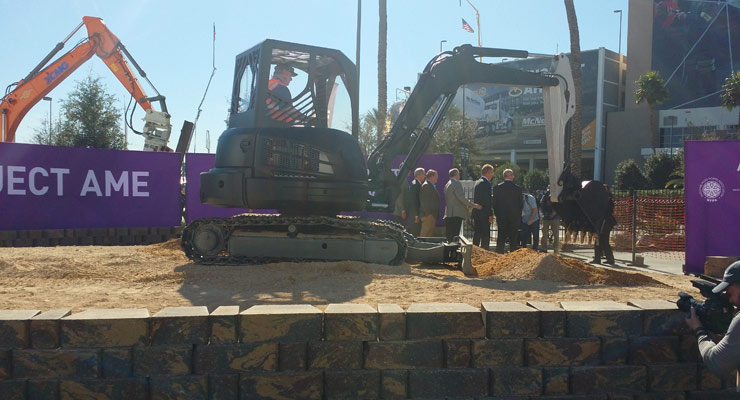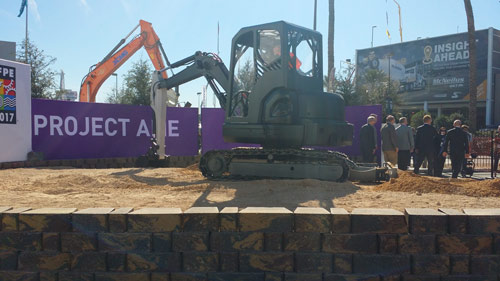Kicking off the Tech Experience at IFPE and CONEXPO-CON/AGG, the unveiling of the 3D-printed excavator—dubbed Project AME—was a fitting start to the “Imagine What’s Next” theme of the two massive shows this year.
 Oak Ridge National Laboratory (ORNL), in collaboration with CCEFP university student designers from the University of Illinois, the University of Minnesota, and Georgia Tech, as well as AEM and the NFPA, worked to create novel designs for the cab, stick and heat exchanger that were all printed at the Department of Energy’s Manufacturing Demonstration Facility located at Oak Ridge National Laboratory.
Oak Ridge National Laboratory (ORNL), in collaboration with CCEFP university student designers from the University of Illinois, the University of Minnesota, and Georgia Tech, as well as AEM and the NFPA, worked to create novel designs for the cab, stick and heat exchanger that were all printed at the Department of Energy’s Manufacturing Demonstration Facility located at Oak Ridge National Laboratory.
The idea for the 3D-printed excavator came during a visit to ORNL, which had recently printed a car for the IMTS show, said Mike Gust, Industry Relations Director for the CCEFP.
Watch the 3D printed excavator in action @IFPEShow #IFPE2017. @DW_Editor @FluidPowerWorld @WTWH_Tom @FPW_KenKorane @DesignWorld pic.twitter.com/AUwSZtQyeG
— Mary Gannon (@DW_MaryGannon) March 7, 2017
Just like other manufacturing methods, those used in the excavator differ widely, said Gust. The cab, which was printed in just half a day, is printed of aircraft-grade composites with carbon reinforcements, which is much lighter. This idea could allow for future customization of cabs designed specifically to the operator.
Printed with a robotic welder from Wolf Robotics, a Lincoln Electric Company, 7-ft long, 400 lob stick was printed in just five days. The metal printer uses a laser-hot wire process for steel and titanium materials. Gust said it took a little over 1,000 passes to manufacture the entire boom. This boom did allow for the elimination of some hose and tubing by printing internal passageways.
“The boom or stick was—for first-time ever that we know of—something that large was printed out of steel,” said Gust.
The powder-bed aluminum heat exchanger was printed using a laser technology which melts the aluminum as it is printing it, creating a pressure-tight design, up to 1,000 psi, said Gust.
The radiator features are just not possible with conventional manufacturing. Hydraulic oil is cooled as it passes through tubes with special internal features to enhance cooling. Air flows over the tubes, which are shaped to reduce the required fan power. The aluminum oil cooler is printed or laser-fused layer by layer by the Concept Laser printer.
 According to University of Minnesota student Brandon Hathaway, “We’re making a ready-to-use drop-in replacement device that can be added to the heat exchanger with very little added operation.”
According to University of Minnesota student Brandon Hathaway, “We’re making a ready-to-use drop-in replacement device that can be added to the heat exchanger with very little added operation.”
“With these heat exchangers, you need a lot of sub-features. On the outside where the air flows through, you need to get a lot of surface area, so you have to add these fins. Ours are at an angle because the printing process doesn’t allow horizontal or vertical ones you’d have in a traditional design,” Hathaway continued.
The tubes running across the fins have a lenticular shape, which is streamlined to help with the airflow. And little fins are staggered on the inside of the tubes. With traditional manufacturing, you couldn’t have both these designs manufactured together. “With 3D printing you have the possibility to incorporate those features together, so that’s one of the big benefits, is that you can take these unique features that are usually separate and put them into a combined device.”
Hathaway said this prototype allows the device to operate and efficiency improvements will come as they refine the device. Currently, it’s comparable to an existing heat exchanger.
Student researchers had some input from Daikin and Adams Thermal, which allowed them to test their device side-by-side with a traditional exchanger at its test facility.
The key to all three components and manufacturing types in the 3D-printed excavator is to at least show they are comparable to current methods of manufacture, and hopefully, to make them stronger, lighter and eventually, more efficient and functional.
“It should be strong enough, so that it’s a functional part. Every one of these is designed to be functional, which is kind of a new wave of 3D printing,” Gust said. “The steel could be a game changer to custom-make what you need.”
As for real-world applications with manufacturers, Gust said the first thing would probably be tooling and fixturing.
Filed Under: Mobile Hydraulic Tips, Slider